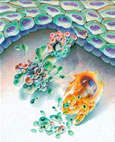|
|
 |
 When cells refuse to die
When cells refuse to die
|
 |
 |
|
|
|
Image: NASA
|
|
|
|
Organisms rid themselves of dangerous cells through apoptosis, programmed
cell death. Tumor cells infamously resist death, whether from chemotherapeutic
drugs or the body's own immune system. Now researchers have found that
the formation of three-dimensional cellular structures confers resistance
to apoptosis in both normal and tumor cells.
 A microlab
to sniff out bioterror A microlab
to sniff out bioterror
By building rugged and inexpensive microfluidic analyzers whose channels
are filled with novel monolithic
porous polymers, researchers have multiplied the efficiency of these
"labs on a chip" in detecting extremely dilute concentrations
of microorganisms, proteins, and smaller molecules in the air, soil, and
water -- including dangerous toxins and biological weapons.
 It was
a very good year It was
a very good year
Saccharomyces cerevisiae, used in the primary fermentation of wine,
does not metabolize harsh-tasting malic acid. But a bacterial backup, Oenococcus
oeni, makes
many wines drinkable by converting malic acid to softer-tasting lactic
acid. Although acid and ethanol tolerant, O. oeni grows sluggishly.
The pace could pick up now that researchers have sequenced its whole genome.

|
|
|